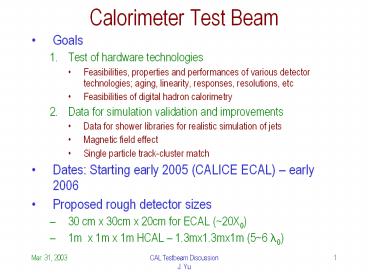CAL Testbeam Discussion PowerPoint PPT Presentation
1 / 9
Title: CAL Testbeam Discussion
1
Calorimeter Test Beam
- Goals
- Test of hardware technologies
- Feasibilities, properties and performances of
various detector technologies aging, linearity,
responses, resolutions, etc - Feasibilities of digital hadron calorimetry
- Data for simulation validation and improvements
- Data for shower libraries for realistic
simulation of jets - Magnetic field effect
- Single particle track-cluster match
- Dates Starting early 2005 (CALICE ECAL) early
2006 - Proposed rough detector sizes
- 30 cm x 30cm x 20cm for ECAL (20X0)
- 1m x 1m x 1m HCAL 1.3mx1.3mx1m (56 l0)
2
- Initial facility requirements
- Beam with wide kinematic ranges at an adequate
rates - Particle types p, K, p, m, e
- Momenta of particles 1 150 GeV w/ 1 momentum
bite - Rate no more than 100Hz
- Beam instrumentation
- 1 beam momentum and position measurements
- PID, such as Cerenkov counters, and selection
- Neutral tagging (TOF)
- Sufficient Mechanical Infrastructure
- Rotational support table
- Crane up to 5 tons
- Floor space 10x10m2
- Length of stay few years
- Length in beam 2-4 months each
3
Comparisons of TB Facilities
Facilities Particles p-ranges Availability Contact
FNAL MTF p, K, p, m, e 5-120 GeV/c From early 2003 E. Ramberg
SLACESA g, e, had lt45GeV e lt13GeV had Available now
IHEP-Protvino had, e, m lt45GeV e 33-45GeV h From 2004
BNL-AGSB2 e, p, K, p, m lt10GeV Dependent on AGS Status
JLab N/A 2007-8 due to upgrade
CERN Pretty bad after 2004
DESY e, e- 1-3(??)GeV Not clear
Frascati Not clear Up to 50GeV Available now
KEK N/A 2004-5
4
How do we organize?
- When do we want to do this and for how long?
- Late 2005 early 2006? Why? For a few years
- Where do we do this?
- Based on the necessary particle types, momentum
range, availability, Fermilab seems to be the
best place to do this. - Who are the participants?
5
Groups Showed Interest in TB
- ECAL
- Si/W (Oregon, R. Frey)
- Crystal detector (U. Mallik)
- HCAL
- Scintillator tile (NIU, D. Chakraborty)
- RPC (ANL, J. Repond)
- GEM (UTA, A. White J. Yu)
- Calorimeter-based luminosity monitoring
- Cerenkov Compensated Calorimetry (Y. Onel)
6
How do we organize?
- When do we want to do this and for how long?
- Late 2005 early 2006? Why? For a few years
- Where do we do this?
- Based on the necessary particle types, momentum
range, availability, Fermilab seems to be the
best place to do this. - Who are the participants?
- What is the setup for testbeam?
7
A Possible LC CAL Testbeam Setup
Beam halo veto scintillator paddles
Tagging scintillator paddles surround CAL modules
Scintillator hodoscopes
Beam
ECAL
Dead material
HCAL
Wire Chambers (3-views)
S. Magill
8
How do we organize?
- When do we want to do this and for how long?
- Late 2005 early 2006? Why? For a few years
- Where do we do this?
- Based on the necessary particle types, momentum
range, availability, Fermilab seems to be the
best place to do this. - Who are the participants?
- What is the setup for testbeam?
- Who builds which part of the setup?
- Each sensitive gap technology construct their own
sensitive gap detectors? - What about DAQ?
- Front-end? Backend? Data recording?
- How about absorber plates for sampling
calorimeters?
9
- What is the readout granularity we want?
- How do we organize TB software development?
- In what time table do we work?
- Where do we obtain financial support for
coordinated effort? DOE? NSF? Each group
figure out by themselves? - What are the other detector groups efforts?
- We need to work together with them to approach
facilities as a concerted group effort.

